| AUGUST 2014 |
|
12 shows in T˘ky˘ (Kabukiza, Shinbashi Enbuj˘, Nihonbashi K˘kaid˘, National Theatre, Shibuya-ku Bunka S˘g˘ Center ďwada, Cerulean Tower N˘ Theater) and 2 in ďsaka (National Bunraku Theatre)!
|
| Kabukiza (T˘ky˘) |  |
| Dates | 5 ~ 27 August 2014 (Hachigatsu N˘ry˘ Kabuki) August Cool-Breeze Kabuki |
| MatinÚe |
Ky˘fu Jidai |
| Afternoon |
Shinshű Kawanakajima Kassen (Terutora Haizen) Tanuki |
| Evening | |
| Casting |
Band˘ Mitsugor˘, Nakamura Senjaku, Nakamura Hashinosuke, Nakamura Kankur˘, Nakamura Shichinosuke, Band˘ Yajűr˘, Nakamura Shid˘, Ichimura Manjir˘, Kataoka Ichiz˘, Kataoka Kamez˘, Band˘ Shűch˘, Band˘ Minosuke, Nakamura Kotar˘, Band˘ Shingo, Nakamura Toranosuke, Nakamura Kunio, Namino Naoya |
| Comments |
The usual summer program at the Kabukiza! It is entitled Hachigatsu N˘ry˘ Kabuki (literally "the August cool-breeze Kabuki"). There is the first stage appearance (omemie) of Nakamura Kankur˘'s son Namino Naoya, who plays the role of Kinbŕ's son Umekichi in Osaragi Jir˘'s drama "Tanuki".
|
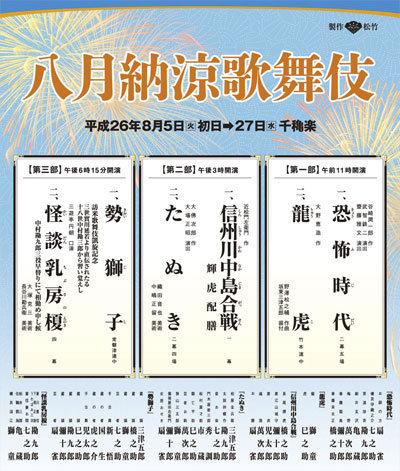 |
| Shinbashi Enbuj˘ (T˘ky˘) |
| Dates | 5 ~ 10 August 2014 (ABKAI - Ebikai) Ebiz˘ Gala |
| Program |
SOU (S˘) |
| Casting | |
| Comments |
2nd edition of ABKAI - Ebikai, the gala of the young star Ichikawa Ebiz˘. The first item in this program is a newly-created dance. The second item is the classic "Kawatsura H˘gen Yakata" of the drama "Yoshitsune Senbon Zakura". Ichikawa Ebiz˘ performs a chűnori at the end of this play. |
|
|||
| Dates | 13 ~ 15 August 2014 (IDOMU ~ Atsuki Yakusha no Arata na Kiseki) Challenge ~ A New Trajectory for a Passionate actor |
||
| Program | |||
| Casting | |||
| Comments |
A gala program called Idomu (Challenge) for the young actor Onoe Matsuya |
||
| National Theatre (T˘ky˘) |
| Dates | 9 ~ 10 August 2014 (Ne no Kai) |
| Program | |
| Comments |
16th edition of the summer program of the association Ne no Kai (literally 'the Sound Association'). |
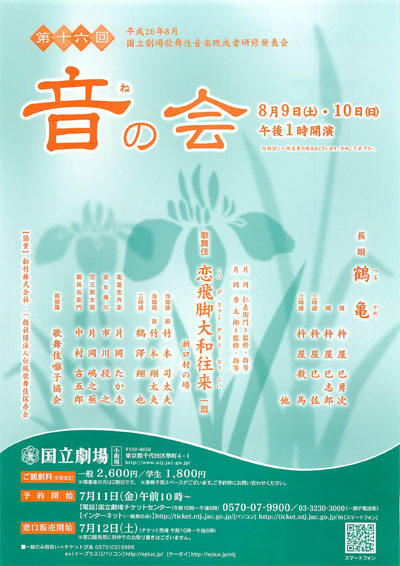 |
| Dates | 14 ~ 18 August 2014 (Chigyokai/Kabukikai) |
| Program |
|
| Comments |
20th edition of the common program for 2 associations, the Chigyokai (the Young Fishes Association) and the Kabukikai (the Kabuki Association), which stars stars' disciples in the leading roles of all the items in the program. |
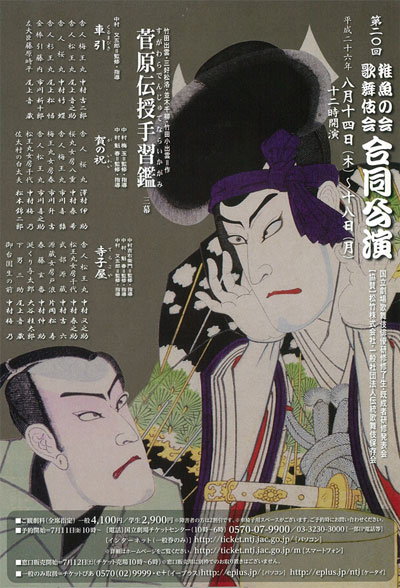 |
| Dates | 21 August 2014 |
| Program |
Genzai D˘j˘ji Teidan Kane no Misaki |
| Casting |
Matsumoto K˘shir˘, Nakamura Kichiemon, Nakamura Shibajaku, ďtani Tomoemon, ďtani Hirotar˘, ďtani Hiromatsu, Nakamura Ky˘z˘ |
| Comments |
A special dance program (Buy˘) which commemorate the 2nd anniversary (3rd memorial service) of the passing away of Living National Treasure Nakamura Jakuemon IV. There are two programs (one afternoon show and one evening show) which are almost identical.
|
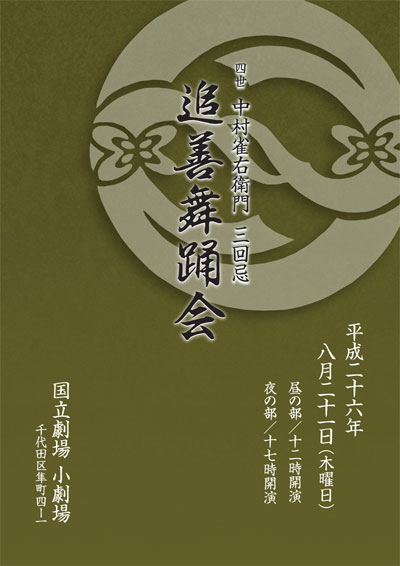 |
| Dates | 22 August 2014 (Yamashiroya Sakata T˘jűr˘) |
| Program | |
| Casting |
Sakata T˘jűr˘, Band˘ Takesabur˘, Kamimura Kichiya, Nakamura Kazutar˘ |
| Comments |
The 8th edition of an NHK-sponsored program, which is called Gei no Shinzui (the Essence of Art in English) and is dedicated to the Living National Treasure Sakata T˘jűr˘.
|
| Dates | 30 ~ 31 August 2014 (Matsuo-juku Kodomo Kabuki) Matsuo Academy of Kabuki ~ Kabuki for Kids Performance |
| Program |
Keisei Hangonk˘ (Domo Mata) Suminuri |
| Comments |
The Matsuo-juku Kodomo Kabuki [website in Japanese] is a kodomo shibai troupe, founded in ďsaka in 1988 by Matsuo Hazue, the wife of Matsuo Kuniz˘ (1899~1984), whose name is closely associated to the Matsuo Artistic Awards (Matsuo Gein˘ Sh˘). The troupe is now led by Matsuo Hazue's daughter Matsuo Hideko. The troupe celebrated its 25th anniversary in 2012. |
| National Bunraku Theatre (ďsaka) |
| Dates | 16 ~ 17 August 2014 (Matsuo-juku Kodomo Kabuki) Matsuo Academy of Kabuki ~ Kabuki for Kids Performance |
| Program |
Shinpan Ukina no Yomiuri (Kuramae) Keisei Hangonk˘ (Domo Mata) Suminuri |
| Comments |
The Matsuo-juku Kodomo Kabuki [website in Japanese] is a kodomo shibai troupe, founded in ďsaka in 1988 by Matsuo Hazue, the wife of Matsuo Kuniz˘ (1899~1984), whose name is closely associated to the Matsuo Artistic Awards (Matsuo Gein˘ Sh˘). The troupe is now led by Matsuo Hazue's daughter Matsuo Hideko. The troupe celebrated its 25th anniversary in 2012. |
| Dates | 23 ~ 24 August 2014 (Kamigata Kabukikai) |
| Program |
Shinshű Kawanakajima Kassen (Terutora Haizen)
|
| Comments |
24th edition of the Kamigata Kabukikai (the Kamigata Kabuki Association), a summer program in ďsaka which stars Kamigata Kabuki stars' disciples in the leading roles of all the items. |
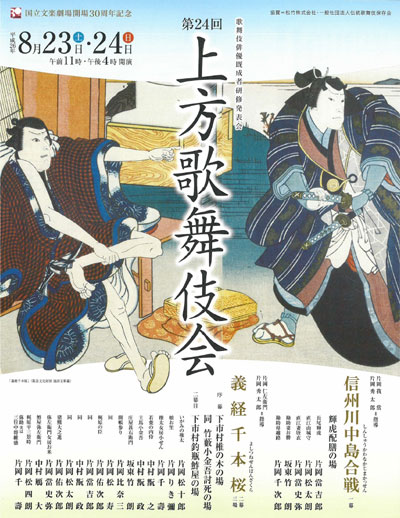 |
| Shibuya-ku Bunka S˘g˘ Center ďwada (T˘ky˘) |  |
| Dates | 15 ~ 17 August 2014 |
| Program |
Kabuki Koku he no Izanai |
| Casting |
Ichikawa Somegor˘, Ichikawa En'ya, Onoe Kikunoj˘ III |
| Comments |
A newly-created Kabuki program full of dances for children based on the legend of the hero Shibuya Konn˘maru. "Kabuki Koku he no Izanai" means "Invitation to the Country of Kabuki". Not for the adults! The first adventures were staged in the same location in November 2010. A website dedicated to this project has opened. |
| Cerulean Tower N˘ Theater (T˘ky˘) |  |
| Dates | 17 August 2014 |
| MatinÚe |
Buy˘ to Nagauta no Tanoshimikata Gor˘ Tokimune |
| Evening |
Buy˘ to Nagauta no Tanoshimikata Miyakodori |
| Casting |
Ichikawa Enshi, Ichikawa Emino |
| Comments |
2nd edition of the Tensh˘kai, a gala for the young actor Ichikawa Enshi, a disciple of Ichikawa Ennosuke. "Buy˘ to Nagauta no Tanoshimikata" is a stage speech which can be translated by "How to enjoy Buy˘ and Nagauta". Others items in this program are dance-dramas. |
|
|
| Contact | Main | Top | Updates | Actors | Plays | Playwrights | Programs | Links | FAQ | Glossary | Chronology | Illustrations | Prints | Characters | Derivatives | Theaters | Coming soon | News |
